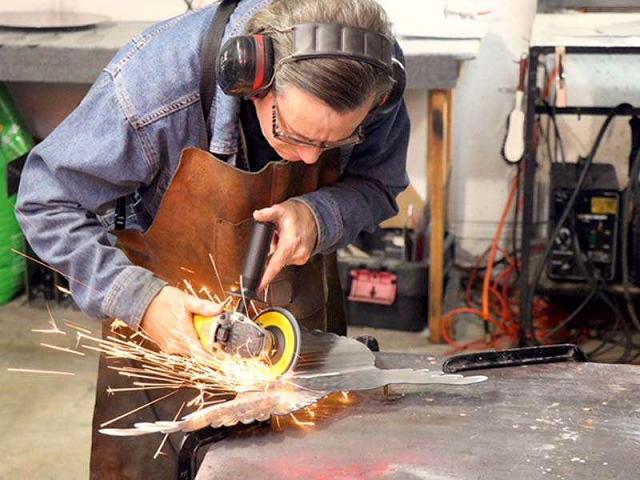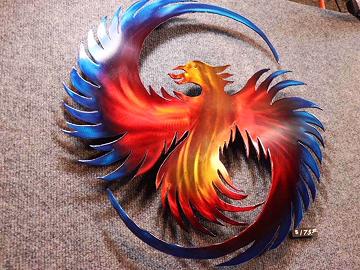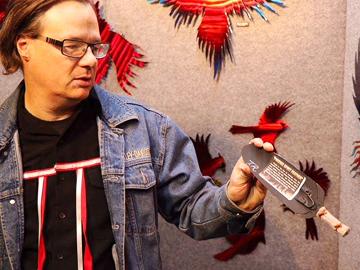 |
Canku Ota
|
 |
|
(Many Paths)
|
||
|
An Online Newsletter
Celebrating Native America
|
||
|
March 2018 - Volume
16 Number 3
|
||
|
|
||
|
Mitchell's Metalwork
Finally Hits Its Stride
|
||
|
by Brittney Bennett
- Cherokee Phoenix reporter
|
||
|
credits: all photos by
Brittney Bennett - Cherokee Phoenix reporter
|
YUKON – Though it's taken several years for Cherokee metal artist Tommy Roe Mitchell to find his stride, his distinctive style is now giving him the opportunity to pursue his passion while stepping out from his father's shadow. He grew up close to the art business, as his father Ron is a well-known Cherokee artist who began his career in the 1970s. While both have experience in metal art, Tommy said he's now setting his work apart with painting and grinding techniques. "Dad was doing metal artwork, but he wasn't doing it to the extent that I am now, not with the color," Tommy said. "He would actually cut the piece out, grind the edges and heat-treat it, but he wasn't putting the grinding marks in it like I have. Dad never even thought about using the grinder the way I was doing, so already this was out of his league." Tommy said he usually draws inspiration from things he sees on television and YouTube. Once he completes a design on sketchpad, he transfers it onto poster board and then onto 14- to 18-gauge sheet metal with a magic marker. The design is then cut with a plasma cutter before he uses a grinder to smooth jagged edges and polish out imperfections. Once satisfied, he grinds grooves into the metal to give the illusion of feathers and depth. "I want a nice, smooth, flat surface to start creating, and that's when I start with the grinding effects," he said. "I want a three-dimensional look. People have come up to it and actually felt behind it because it looks thicker than it really is. It's just the way the grinding is." Once the overall look comes together, Tommy heat-treats the piece or moves it to his paint booth before sealing it with an automotive clear coat for a smooth finish. While expanding his range to include hummingbirds and cardinals, his roots lie in mythical symbolism, including his piece "Dance of the Phoenix." "Metal artists, they like doing the eagle feathers. I wanted to do something similar, but I don't want to copy anybody's work. We thought, 'Phoenix, why not?' Who knows what a Phoenix feather looks like? It's a mythical bird so this is my interpretation of what the flaming feathers look like. It's the bird that rose from the fire, kind of like me." In addition to creating versions of the phoenix, Tommy creates his interpretation of what individual feathers might look like on the creature. The feathers are called "Phoenix Spirit Feathers." He has also taken inspiration from Cherokee myths and legends, including that of the Raven Mocker, a feared witch that preys on the sick and frail. "I was wanting something a little scary, and I started looking into the Cherokee myths, and we came up with something rather scary, which was the Raven Mocker," he said. "That one is just a little more dramatic, a little more scary." Strangely enough, the blooming of Tommy's metalwork came after being diagnosed with acute anxiety disorder. "When I was diagnosed with acute anxiety disorder, I did not want to rely on the medication. They gave me that to begin with, and I couldn't take it. I struggled with that so we talked to a therapist, and he suggested art is a relaxing way of dealing with stress. So I thought, 'OK, I can do this. This is something right up my alley.'" Tommy said this is the first time his artwork has been something he "truly enjoys" and is "eager" for the public to see more. "I think they're really nice-looking, and I feel really comfortable doing it. The greatest compliment on this artwork is when I take it to an art show and someone loves it so much that they're willing to pay for it and take it home and hang it up on their walls. That's the compliment that I like." For more information, visit www.dragonfiremetalart.net or search "DragonFire Metal Art" on Facebook. |
|||||||||||||||
|
|
|
|
||
|
|
||
| Canku Ota is a free Newsletter celebrating Native America, its traditions and accomplishments . We do not provide subscriber or visitor names to anyone. Some articles presented in Canku Ota may contain copyright material. We have received appropriate permissions for republishing any articles. Material appearing here is distributed without profit or monetary gain to those who have expressed an interest. This is in accordance with Title 17 U.S.C. Section 107. | ||
|
Canku Ota is a copyright ©
2000 - 2018 of Vicki Williams Barry and Paul Barry.
|
||
 |
 |
|
|
The "Canku
Ota - A Newsletter Celebrating Native America" web site and
its design is the
|
||
|
Copyright ©
1999 - 2018 of Paul C. Barry.
|
||
|
All Rights Reserved.
|
||




